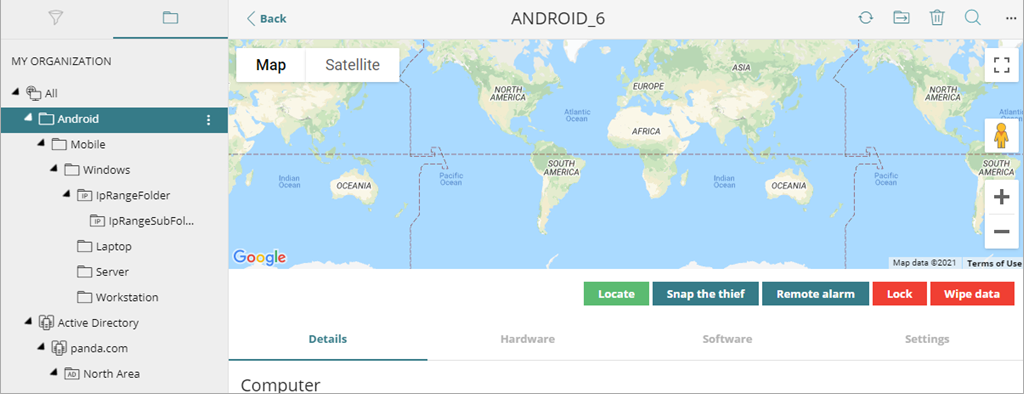Applies To: WatchGuard Advanced EPDR, WatchGuard EPDR, WatchGuard EPP
For Android devices, the upper half of the details page includes an anti-theft dashboard from which you can start remote actions on a managed device.
For more information on how to enable the anti-theft feature for Android devices and configure private mode, see Configure Anti-Theft Settings for Android Devices.

These actions are available below the map on the anti-theft dashboard:
Locate
Locates the Android device on the map.
With private mode enabled, the management UI opens a window that prompts you to enter the code entered by the device user to enable private mode. When you enter the correct code, WatchGuard Endpoint Security gets the device coordinates and shows the device location on the map.
With private mode disabled, the WatchGuard server gets the device coordinates and shows the device location on the map.
For more information, see Locate a Device (Android and iOS devices).
Snap the Thief
Takes a photo of the device user and sends it to a specified email address. This feature is not available if the user has privacy mode enabled on the device. For more information, see Snap the Thief (Android devices).
Remote Alarm
Sends an audible alarm and message to the device. For more information, see Send a Remote Alarm (Android and iOS devices).
Lock
Locks the device and requires the user to enter a 4-digit code to open the device.
For Android devices lower than version 7, the management UI prompts you to create a PIN, which is then used to lock the device.
For Android devices (versions 7 to 11), if a PIN was previously created by the user, it is used to lock the phone. If a PIN was never created, the management UI prompts you to create one and uses it to lock the phone.
For Android devices higher than version 11, the management UI does not prompt you to create a PIN. If a PIN was previously created by the user, it is used to lock the phone. If a PIN was never created, the device screen turns off.
For more information, see Lock a Device (Android and iOS devices).
Wipe Data
Deletes all content and applications from the device. The device returns to factory settings. For more information, see Wipe Device Data (Android and iOS devices).
The lower half of the details page includes these tabs:
- Details — Shows a summary of the hardware, software, and security settings of the device.
- Hardware — Shows a summary of the hardware properties, such as CPU, Memory, Disk, and BIOS.
- Software — Shows the software packages installed on the device, as well as versions and changes. To show a history of all software changes made to the device, click Installations and Uninstallations.
- Settings — Shows security settings assigned to the device. To select a different security profile and specify inheritance, click Change. To edit the security profile, click Go to Settings.
For more information on how to create and edit settings profiles, refer to Manage Settings.